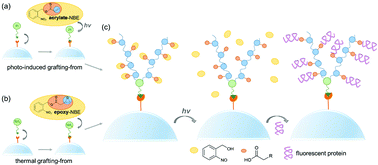Hybrid silica micro-particles with light-responsive surface properties and Janus-like character†
Abstract
The present work highlights the synthesis and post-modification of silica-based micro-particles containing photo-responsive polymer brushes with photolabile o-nitrobenzyl ester (o-NBE) chromophores. For the synthesis of the polymer brushes, two different procedures were pursued. In the first approach, an amino-functional organosilane was covalently attached onto the silica surface followed by the thermal coupling of a mono-functional epoxy monomer containing o-NBE groups. In the second approach, a long wavelength absorbing Norrish Type I photoinitiator bearing functional trialkoxy silane moieties was immobilized across the silanol groups of the silica surface by condensation reaction. Upon visible light exposure, the photoinitator was homolytically cleaved and the formed radicals acted as anchor points for a grafting-from reaction. In particular, an acrylate monomer with o-NBE groups was grafted onto the surface of the micro-particles without inducing a premature cleavage of the o-NBE links. The photo-induced grafting reaction enabled the formation of photo-responsive polymer brushes within short reaction time and under mild reaction conditions. Once the polymer brushes were formed, the o-NBE groups were selectively cleaved upon UV light exposure. Additionally, particles with Janus-like properties were synthetized by first masking the grafted silica particles through a wax-water Pickering emulsion, followed by a selective UV irradiation of the unmasked particles’ domain. The formed carboxylic acid moieties were then used for the covalent attachment of a fluorescent biomolecule (Alexa Fluor546 conjugated Protein A). Zeta potential experiments and XPS spectroscopy confirmed the changes in the chemical surface composition of the silica particles prior to and after the surface modification and photocleavage processes. In addition, confocal microscopy images proved the selective anchoring of a fluorescent protein onto the surface of UV irradiated particles surface areas, giving rise to the versatility of o-NBE chemistry for the fabrication of light-responsive hybrid particles.

- This article is part of the themed collection: Synthetic Methodologies for Complex Macromolecular Structures


 Please wait while we load your content...
Please wait while we load your content...